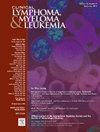Melphalan 140 mg/m2 is Safe and Effective for Frail and Older Multiple Myeloma Patients With Comparable Rates of Minimal Residual Disease Negativity
IF 2.7
4区 医学
Q2 HEMATOLOGY
引用次数: 0
Abstract
Background
Despite therapeutic advances, multiple myeloma (MM) remains challenging to treat effectively. High-dose melphalan (Mel200) with autologous stem cell transplantation (ASCT) is the standard treatment for transplant-eligible patients. Reduced-dose melphalan (Mel140) is an alternative for older or frail patients, yet its efficacy data remain unclear.
Methods
We retrospectively analyzed 233 MM patients undergoing first ASCT between 2014 and 2022, comparing outcomes between Mel140 (n = 82) and Mel200 (n = 151). We assessed patient demographics, disease characteristics, progression-free survival (PFS), and overall survival (OS). In an exploratory subset analysis achievement of MRD from bone marrow samples after ASCT was compared between the 2 groups.
Results
As expected, patients who received Mel 140 were significantly older with a higher KPS. Median follow-up was 47.7 months. Both groups had similar rates of readmissions and infections within the first 100 days after transplant despite Mel140 group being older with more comorbidities. No significant difference in PFS or OS was observed between Mel140 and Mel200 groups (P > .05). MRD negativity rates at sensitivity levels of 10−5 and 10−6 were comparable (64% vs. 60%, P = .7). Patients achieving sustained MRD negativity demonstrated improved PFS regardless of melphalan dose.
Conclusion
Our findings suggest equivalent efficacy and safety profiles between Mel140 and Mel200, supporting Mel140 as a viable option for older or frail MM patients. In a subset analysis equivalent rates of MRD were achieved between the groups and remained a highly significant predictor of PFS, highlighting its relevance regardless of dosing strategies.
Melphalan 140 mg/m2对于虚弱和老年多发性骨髓瘤患者是安全有效的,并且具有相当的最小残留疾病阴性率。
背景:尽管治疗取得了进展,但多发性骨髓瘤(MM)的有效治疗仍然具有挑战性。大剂量美法兰(Mel200)联合自体干细胞移植(ASCT)是适合移植患者的标准治疗方法。减少剂量melphalan (Mel140)是老年人或体弱患者的替代药物,但其疗效数据尚不清楚。方法:我们回顾性分析了2014年至2022年间接受首次ASCT的233例MM患者,比较了Mel140 (n = 82)和Mel200 (n = 151)的结果。我们评估了患者人口统计学、疾病特征、无进展生存期(PFS)和总生存期(OS)。在一项探索性亚群分析中,比较了两组患者ASCT后骨髓样本的MRD结果。结果:正如预期的那样,接受Mel 140的患者明显年龄较大,KPS较高。中位随访时间为47.7个月。尽管Mel140组年龄较大,合并症较多,但两组移植后100天内的再入院率和感染率相似。Mel140组和Mel200组PFS和OS无显著差异(P < 0.05)。10-5和10-6敏感性水平的MRD阴性率具有可比性(64% vs. 60%, P = 0.7)。达到持续MRD阴性的患者表现出改善的PFS,与美法仑剂量无关。结论:我们的研究结果表明Mel140和Mel200之间的疗效和安全性相当,支持Mel140作为老年或体弱MM患者的可行选择。在一个子集分析中,两组之间的MRD达到了相当的比率,并且仍然是PFS的一个非常重要的预测指标,强调了其与给药策略的相关性。
本文章由计算机程序翻译,如有差异,请以英文原文为准。
求助全文
约1分钟内获得全文
求助全文
来源期刊

Clinical Lymphoma, Myeloma & Leukemia
ONCOLOGY-HEMATOLOGY
CiteScore
2.70
自引率
3.70%
发文量
1606
审稿时长
26 days
期刊介绍:
Clinical Lymphoma, Myeloma & Leukemia is a peer-reviewed monthly journal that publishes original articles describing various aspects of clinical and translational research of lymphoma, myeloma and leukemia. Clinical Lymphoma, Myeloma & Leukemia is devoted to articles on detection, diagnosis, prevention, and treatment of lymphoma, myeloma, leukemia and related disorders including macroglobulinemia, amyloidosis, and plasma-cell dyscrasias. The main emphasis is on recent scientific developments in all areas related to lymphoma, myeloma and leukemia. Specific areas of interest include clinical research and mechanistic approaches; drug sensitivity and resistance; gene and antisense therapy; pathology, markers, and prognostic indicators; chemoprevention strategies; multimodality therapy; and integration of various approaches.
 求助内容:
求助内容: 应助结果提醒方式:
应助结果提醒方式:


